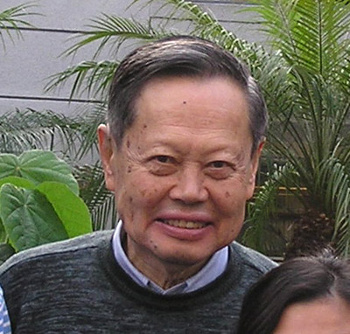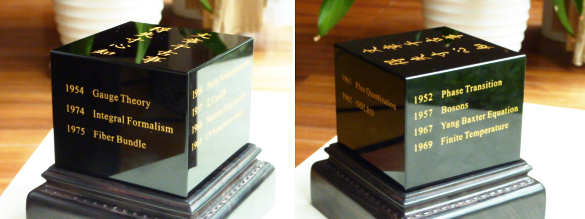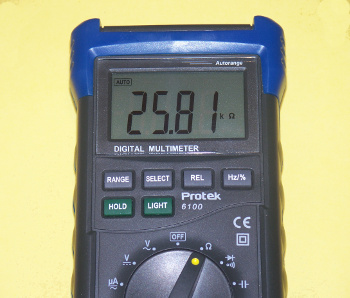C.N. Yang
February 27, 2017
Physicist,
Chen-Ning Yang, who is usually identified as "C.N. Yang" in the
scientific literature, was the recipient of the 1957
Nobel Prize in Physics which he shared with fellow physicist,
Tsung-dao Lee, for their prediction of
parity non-conservation in processes that involve the
weak nuclear force. The weak nuclear force is one of the four known
fundamental forces of nature that include the
strong nuclear force,
gravitation, and
electromagnetism.
The weak force and electromagnetism are now thought to be manifestations of a single force, the
electroweak force, that will be evident at very high
energies (about 100
GeV). The weak force mediates
nuclear reactions that involve
beta decay or
alpha decay. Before Yang and Lee's
theory, it was thought that such reactions would appear the same when viewed in a
mirror. This parity-inversion
symmetry is one of the many symmetries seen in
physics. I wrote about symmetries in an
earlier article (CPT Symmetry, October 29, 2015).

C. N. Yang as he appeared about a decade ago.
(Via Wikimedia Commons.)
Parity-inversion symmetry is nearly always seen in beta decay, so you need to look long and hard to find the few
counterexamples. A
1956 experiment involving the beta decay of
cobalt-60 by physicist,
Chien-Shiung Wu (1912-1997), revealed the non-conservation of parity. Non-conservation of parity means that it's possible to have an
experiment distinguish
left from right. One use for this would be to distinguish
left from right in
communication with an
extraterrestrial civilization.
While it was proven that parity is not always conserved, there was hope that a combination of symmetries involving both
charge (C) and parity (P) might still hold, but
James Cronin and
Val Fitch found
CP violation in
neutral kaon decay in 1964. The reason why
our universe is made of matter, and not an equal mixture of
matter and
antimatter, might be explained by CP violation.
Presently, it appears that adding
time-reversal (T) symmetry into the mix for a combined
CPT symmetry is a valid symmetry. The consequence of CPT symmetry is that an antimatter universe (C) that's a mirror image of our own (P) in which particle
momentum is reversed (T) would have the same
laws of physics that we observe. CPT has been confirmed in all experiments to date; but, as can be imagined, such experiments have become much more difficult than Wu's 1956 experiment that demolished P symmetry.
Yang, who was born on born on October 1, 1922, was a
young man in his mid-30s when he
published his theory of the weak interaction, and he did much interesting work after that. On the occasion of his 90th
birthday in 2012, he was presented with a black "
cube" of dimensions 8
cm x 8 cm x 6.6 cm
engraved with a birthday congratulation, two lines in
Chinese from
Tu Fu (712-770), "A piece of
Literature is meant for the
millennium, but its ups and downs are known already in the
author's heart," and a list of his thirteen significant contributions to
statistical mechanics,
condensed matter physics,
particle physics, and
field theory, ordered by date (see figure).[1]

The presentation to C.N. Yang on the occasion of his 90th birthday. (Modified arXiv image from Ref. 1.)[1)]
Just posted on
arXiv is a copy of a paper published in honor of that occasion by Yu Shi in a 2014 issue of the
International Journal of Modern Physics A.[2] Here's the list of Yang's 13 significant contributions, as engraved on the cube, listed by topic area and year.[1]
Statistical Mechanics
1952-Phase Transition
1957-Bosons
1967-Yang-Baxter Equation
1969-Finite Temperature
Condensed Matter Physics
1961-Flux Quantization
1962-Off-Diagonal Long-Range Order
Particle Physics
1956-Parity Nonconservation
1957-T, C and P
1960-Neutrino Experiment
1964-CP Nonconservation
Field Theory
1954-Gauge Theory
1974-Integral Formalism
1975-Fiber Bundle
While I'm not skilled in particle physics and not comfortable reading papers that are
mathematically dense, I did work in the field of
superconductivity for a time. In this area of condensed matter physics, Yang and co-author,
Nina Byers, explained the
magnetic flux quantization in superconducting
rings observed at
Stanford University (Stanford, CA) by
Bascom S. Deaver and
William M. Fairbank.[3-4] In such rings, the
magnetic flux is
quantized in units of
hc/2e, where
h is the
Planck constant,
c is the
speed of light, and
e is the
electric charge. The
quantum of magnetic flux is 2.0678 x 10
-15 weber.
One important feature of this
equation is the factor of two. The
BCS theory of superconductivity, published in 1957, predicted that
supercurrent is carried by
electron pairs, called
Cooper pairs. While this theory explained many unusual features of superconductivity, such as the
isotope effect, flux quantization very dramatically provided evidence for Cooper pairs.[5]
The quantum of magnetic flux can be measured to great precision using
Josephson junction devices. Combining such a measurement with the
quantum Hall effect allows a very accurate estimate of the Planck constant. The quantum Hall effect gives a value for an
electrical resistance RK called the
von Klitzing constant,
RK=h/(e2). It's interesting that there's a quantum of electrical resistance, ≈25812.80756 ohms, but it's more important that a combination of precise measurements will yield an excellent calculated value for
h.

Not NIST precision
The quantum resistance value, about 25.81 kohm, as simulated with a variable resistor and measured on a digital multimeter.
(Photo by author).)
![]()
References:
- Yu Shi, "Beauty and Physics: 13 Important Contributions of Chen Ning Yang," arXiv, February 7, 2017.
- Yu Shi, "Beauty and Physics: 13 Important Contributions of Chen Ning Yang," International Journal of Modern Physics A, vol. 29, no. 17 (June 13, 2014), Article No. 1475001 (10 pages), DOI: 10.1142/S0217751X14750013.
- N. Byers and C. N. Yang, "Theoretical Considerations Concerning Quantized Magnetic Flux in Superconducting Cylinders," Phys. Rev. Lett., vol. 7, no. 2 (July 15, 1961), pp. 46-49, doi:10.1103/PhysRevLett.7.46.
- Bascom S. Deaver, Jr., and William M. Fairbank, "Experimental Evidence for Quantized Flux in Superconducting Cylinders," Phys. Rev. Lett., vol. 7, no. 2 (July 15, 1961), pp. 43-46, DOI:https://doi.org/10.1103/PhysRevLett.7.43.
- David Lindley, "Focus: Landmarks—Superconductor Quantizes Magnetic Field," Physics, vol. 8, no. 102 (October 23, 2015).
Permanent Link to this article
Linked Keywords: Physicist; Chen-Ning Yang; scientific literature; Nobel Prize in Physics; Tsung-dao Lee; parity; conservation law; non-conservation; weak interaction; weak nuclear force; fundamental interaction; fundamental forces of nature; strong interaction; strong nuclear force; gravity; gravitation; electromagnetism; electroweak interaction; electroweak force; energy; energies; electronvolt; GeV; nuclear reaction; beta decay; alpha decay; theory; mirror; symmetry; physics; decade; Wikimedia Commons; counterexample; Wu experiment; cobalt-60; Chien-Shiung Wu (1912-1997); experiment; relative direction; left; right; communication; extraterrestrial civilization; charge; James Cronin; Val Fitch; CP violation; neutral kaon; radioactive decay; baryogenesis; matter; antimatter; T-symmetry; time-reversal symmetry; CPT symmetry; momentum; physical law; laws of physics; youth; young man; birthday; cube; centimeter; cm; engraved; Chinese language; Du Fu; Tu Fu (712-770); literature; millennium; author; statistical mechanics; condensed matter physics; particle physics; quantum field theory; arXiv; International Journal of Modern Physics A; phase transition; boson; Yang-Baxter equation; thermal quantum field theory; finite temperature; magnetic flux quantum; flux quantization; coherence; off-diagonal long-range order; Cowan-Reines neutrino experiment; gauge Theory; Mills Lagrangian; integral formalism; fiber bundle; mathematics; superconductivity; Nina Byers; magnetic flux quantization; torus; ring; Stanford University (Stanford, CA); Bascom S. Deaver; William M. Fairbank; magnetic flux; quantization; quantize; Planck constant; speed of light; electric charge; quantum mechanics; quantum; weber; equation; BCS theory of superconductivity; supercurrent; electron; Cooper pair; isotope effect; Josephson effect; Josephson junction device; quantum Hall effect; electrical resistance; Klaus von Klitzing; von Klitzing constant; National Institute of Standards and Technology; NIST; precision; ohm; kohm; potentiometer; variable resistor; digital multimeter.